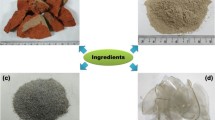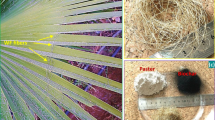Abstract
The building sector has faced significant challenges due to its high energy consumption and waste management issues. Huge amounts of construction and demolition waste are abandoned in the streets or accumulated in landfills each year, which can negatively impact the environment if it’s not managed correctly. Moreover, the use of heating and cooling systems is the major reason for making the building sector the most energy-harvesting sector and raising its greenhouse gas emissions. To deal with this situation, the demand for heat insulation materials has increased recently. This study suggests a promising solution lies in using waste brick as a precursor for aerogel synthesis instead of expensive and toxic organosiloxane precursors. This is a more cost-effective, feasible, and environmentally friendly approach to producing aerogel in comparison with previous works. Using a sol-gel process and ambient pressure drying technique, we could synthesize aerogel in a short time. Throughout the synthesis of aerogels, physical and chemical characterizations have been done. As a result, XRF analysis confirms that the waste contains 76% silicone and aluminum, which makes it a good precursor. Second, the prepared aerogel has a low density of 0.33 g/cm3 in addition to a highly porous network with a porosity of 84.76%. Finally, in order to characterize its thermal performance, different concentrations of aerogel were incorporated into the HDPE matrix. The composite panels were tested using the heat flow meter method. The results showed a decrease in thermal conductivity of 18%, 34%, and 47% by adding 5, 10, and 15% of aerogel, respectively. So, the as-fabricated WB aerogel panels have good thermal performance and great potential for eco-friendly and energy-efficient design for construction purposes.
Graphical Abstract

Highlights
-
New method for recycling demolition and construction waste.
-
Red brick waste as a novel aerogel precursor.
-
The developed HDPE-aerogel panels exhibit both excellent thermal conductivity and low moisture content.
-
Thermal conductivity of HDPE-aerogel composite panels achieved 0.066 W/m.K.






Similar content being viewed by others
References
AMEE/Guide technique sur l’isolation thermique du bâtiment au maroc, “Guide technique sur l’isolation thermique du bâtiment au maroc,” p. 114, 2016
Heating - IEA. https://www.iea.org/energy-system/buildings/heating#tracking (accessed Jul. 19, 2023)
National Agency for Energy Development and Energy Efficiency, “Construction thermal regulation in Morocco (Guide),” p. 47, 2015.
Wongsa A, Sata V, Nematollahi B, Sanjayan J, Chindaprasirt P (2018) Mechanical and thermal properties of lightweight geopolymer mortar incorporating crumb rubber. J Clean Prod 195:1069–1080. https://doi.org/10.1016/j.jclepro.2018.06.003
Colangelo F et al. (2018) Mechanical and thermal properties of lightweight geopolymer composites. Cem Concr Compos 86:266–272. https://doi.org/10.1016/j.cemconcomp.2017.11.016
Ouhaibi S et al. (2021) Thermally insulating gypsum composites incorporating aerosil for sustainable energy-saving buildings. J Build Eng 43:102848. https://doi.org/10.1016/j.jobe.2021.102848
Zhang Y, Sun X, Medina MA (2023) Thermal performance of concrete masonry units containing insulation and phase change material. J Build Eng 76:107184. https://doi.org/10.1016/j.jobe.2023.107184
Patel B et al. (2023) Location optimization of phase change material for thermal energy storage in concrete block for development of energy efficient buildings. Renew Energy 218:119306. https://doi.org/10.1016/j.renene.2023.119306
Welsch T, Vievers Y, Schnellenbach-Held M, Bialuschewski D, Milow B (2023) Comparison of Different Aerogel Granules for Use as Aggregate in Concrete. Gels 9:no. 5. https://doi.org/10.3390/gels9050406
Ganobjak M et al. (2023) Current Trends in Aerogel Use in Heritage Buildings: Case Studies from the Aerogel Architecture Award 2021. Gels 9:no. 10. https://doi.org/10.3390/gels9100814
Hasanzadeh R, Azdast T, Lee PC, Park CB (2023) A review of the state-of-the-art on thermal insulation performance of polymeric foams. Therm Sci Eng Prog 41:101808. https://doi.org/10.1016/j.tsep.2023.101808
Zhang A, Wang J, Wang G, Jiang L, Meng X, Zhao G (2023) Microcellular injection molded lightweight, strong and thermally insulating PP/fibrillated-PTFE composite foams with enhanced surface appearance. J Mater Res Technol 22:2933–2943. https://doi.org/10.1016/j.jmrt.2022.12.160
Ma Q et al. (2023) New bio-based polyurethane (PU) foams synthesized using crude glycerol-based biopolyol and humin-based byproducts from biomass hydrolysis. Ind Crops Prod 205:117548. https://doi.org/10.1016/j.indcrop.2023.117548
Liu G, Guo Y, Jian Z, Huang M, Zhao T (2023) Experimental Study on the Thermal Conductivity of Improved Graphite Composite Insulation Boards. Crystals 13:1–23. https://doi.org/10.3390/cryst13010102
Neupane K (2022) Evaluation of environmental sustainability of one-part geopolymer binder concrete. Clean Mater 6:100138. https://doi.org/10.1016/J.CLEMA.2022.100138
Lian TW, Kondo A, Kozawa T, Ohmura T, Tuan WH, Naito M (2015) Effect of fumed silica properties on the thermal insulation performance of fibrous compact. Ceram Int 41:9966–9971. https://doi.org/10.1016/J.CERAMINT.2015.04.076
Yan Q, Feng Z, Luo J, Xia W (2022) Preparation and characterization of building insulation material based on SiO2 aerogel and its composite with expanded perlite. Energy Build 255:111661. https://doi.org/10.1016/J.ENBUILD.2021.111661
Ahmad S, Ahmad S, Sheikh JN (2023) Silica centered aerogels as advanced functional material and their applications: A review. J Non Cryst Solids 611:122322. https://doi.org/10.1016/J.JNONCRYSOL.2023.122322
Lu Y, Liu Z, Li X, Jiang Yin X, Djati Utomo H (2022) Development of water-based thermal insulation paints using silica aerogel made from incineration bottom ash. Energy Build 259:111866. https://doi.org/10.1016/J.ENBUILD.2022.111866
Gomes MG, Flores-Colen I, da Silva F, Pedroso M (2018) Thermal conductivity measurement of thermal insulating mortars with EPS and silica aerogel by steady-state and transient methods. Constr Build Mater 172:696–705. https://doi.org/10.1016/J.CONBUILDMAT.2018.03.162
Wu H, Zhang H, Zhang G, Liu J, Liu Z, Du F (2023) Study on preparation and performance of advanced aerogel foamed concrete with ultra-light aerogel. Constr Build Mater 366:130166. https://doi.org/10.1016/J.CONBUILDMAT.2022.130166
Huang Y, Lei Niu J (2015) Application of super-insulating translucent silica aerogel glazing system on commercial building envelope of humid subtropical climates – Impact on space cooling load. Energy 83:316–325. https://doi.org/10.1016/J.ENERGY.2015.02.027
Berardi U, Kisilewicz T, Kim S, Lechowska A, Paulos J, Schnotale J (2020) Experimental and numerical investigation of the thermal transmittance of PVC window frames with silica aerogel. J Build Eng 32:101665. https://doi.org/10.1016/J.JOBE.2020.101665
Ganesamoorthy R, Vadivel VK, Kumar R, Kushwaha OS, Mamane H (2021) Aerogels for water treatment: A review. J Clean Prod 329:129713. https://doi.org/10.1016/J.JCLEPRO.2021.129713
Thakur A (2022) Graphene aerogel based energy storage materials – A review. Mater Today Proc, https://doi.org/10.1016/J.MATPR.2022.05.477
Berthon-Fabry S, Hildenbrand C, Ilbizian P, Jones E, Tavera S (2017) Evaluation of lightweight and flexible insulating aerogel blankets based on Resorcinol-Formaldehyde-Silica for space applications. Eur Polym J 93:403–416. https://doi.org/10.1016/J.EURPOLYMJ.2017.06.009
Manzocco L, Mikkonen KS, García-González CA (2021) Aerogels as porous structures for food applications: Smart ingredients and novel packaging materials. Food Struct 28:100188. https://doi.org/10.1016/J.FOOSTR.2021.100188
Zheng L, Zhang S, Ying Z, Liu J, Zhou Y, Chen F (2020) Engineering of aerogel-based biomaterials for biomedical applications. Int J Nanomed 15:2363–2378. https://doi.org/10.2147/IJN.S238005
Maleki H, Durães L, García-González CA, del Gaudio P, Portugal A, Mahmoudi M (2016) Synthesis and biomedical applications of aerogels: Possibilities and challenges. Adv Colloid Interface Sci 236:1–27. https://doi.org/10.1016/J.CIS.2016.05.011
Ferreira-Gonçalves T, Constantin C, Neagu M, Reis CP, Sabri F, Simón-Vázquez R (2021) Safety and efficacy assessment of aerogels for biomedical applications. Biomed Pharmacother 144:112356. https://doi.org/10.1016/J.BIOPHA.2021.112356
Liu H, Geng B, Chen Y, Wang H (2017) Review on the Aerogel-Type Oil Sorbents Derived from Nanocellulose. ACS Sustain Chem Eng 5(1):49–66
H24info (2022) Casablanca: 1,3 million de tonnes de déchets de construction à l’abando, https://www.h24info.ma/, Accessed: Oct. 19, 2022
Dervin S, Pillai SC (2017) An Introduction to Sol-Gel Processing for Aerogels. In: Sol-Gel Materials for Energy, Environment and Electronic Applications, pp. 1–22. Springer. https://doi.org/10.1007/978-3-319-50144-4_1
Lamy-Mendes A, Pontinha ADR, Alves P, Santos P, Durães L (2021) Progress in silica aerogel-containing materials for buildings’ thermal insulation. Constr Build Mater 286:122815. https://doi.org/10.1016/J.CONBUILDMAT.2021.122815
Almeida CMR, Ghica ME, Durães L (2020) An overview on alumina-silica-based aerogels. Adv Colloid Interface Sci 282, https://doi.org/10.1016/j.cis.2020.102189
Boukind S et al. (2022) Ambient Pressure Drying as an Advanced Approach to the Synthesis of Silica Aerogel Composite for Building Thermal Insulation. J Nat Fibers 19:10142–10156. https://doi.org/10.1080/15440478.2021.1993486
Shewale PM, Rao AV, Rao AP (2008) Effect of different trimethyl silylating agents on the hydrophobic and physical properties of silica aerogels. Appl Surf Sci 254:6902–6907. https://doi.org/10.1016/j.apsusc.2008.04.109
Sarawade PB, Kim J-K, Park J-K, Kim H-K (2006) Influence of Solvent Exchange on the Physical Properties of Sodium Silicate Based Aerogel Prepared at Ambient Pressure. Aerosol Air Qual Res 6:93–105. https://doi.org/10.4209/aaqr.2006.03.0008
Liu Z et al. (2021) Atmospheric drying preparation and microstructure characterization of fly ash aerogel thermal insulation material with superhydrophobic. Constr Build Mater 303:124425. https://doi.org/10.1016/j.conbuildmat.2021.124425
Luo Z et al. (2022) Effect of residual Na+ on the properties of aerogel prepared with sodium silicate via APD. J Non Cryst Solids 575, https://doi.org/10.1016/j.jnoncrysol.2021.121200
He F, Wang Y, Zheng W, Wu JY, Huang YH (2022) Effective thermal conductivity model of aerogel thermal insulation composite. Int J Therm Sci 179:107654. https://doi.org/10.1016/j.ijthermalsci.2022.107654
Kim GS, Hyun SH (2003) Effect of mixing on thermal and mechanical properties of aerogel-PVB composites. J Mater Sci 38:1961–1966. https://doi.org/10.1023/A:1023560601911
Oktay H, Argunhan Z, Yumrutaş R (2016) An investigation of the influence of thermophysical properties of multilayer walls and roofs on the dynamic thermal characteristics. Dergipark Org Tr 2(1):48–54. https://dergipark.org.tr/en/pub/muglajsci/issue/25592/269972
Özlüsoylu Ï, İstek A (2019) The Effect of Hybrid Resin Usage on Thermal Conductivity in Ecological Insulation Panel Production. In: Conference: 4th International Conference on Engineering Technology and Applied Sciences, 292–296. Available: https://www.researchgate.net/publication/333164278_The_Effect_of_Hybrid_Resin_Usage_on_Thermal_Conductivity_in_Ecological_Insulation_Panel_Production
Ilomets S, Kuusk K, Paap L, Arumägi E, Kalamees T (2017) Impact of linear thermal bridges on thermal transmittance of renovated apartment buildings. J Civ Eng Manag 23:96–104. https://doi.org/10.3846/13923730.2014.976259
Tadjarodi A, Haghverdi M, Mohammadi V (2012) Preparation and characterization of nano-porous silica aerogel from rice husk ash by drying at atmospheric pressure. Mater Res Bull 47:2584–2589. https://doi.org/10.1016/j.materresbull.2012.04.143
Acknowledgements
The authors would like to thank the technical center of plastics and rubber for their assistance with this study by supplying the chemicals required for aerogel manufacturing and allowing us to use their equipment.
Author contributions
OA conceived, designed the presented idea, and carried out the experimental work. Moreover, she has written the whole body of the manuscript and analyzed the data to generate XRD, thermal conductivity, and FTIR figures and graphics. Moreover, interpreting and discussing the results of different analyses in the manuscript. LE contributed to this work by supplying the raw materials and equipments (internal mixers, heated platen presses) necessary for the manufacturing of aerogel panels. Besides providing instruments for aerogel characterization, mainly FTIR and thermal conductivity, MJ and NB, revised the manuscript and provided the necessary corrections and improvements to the work. AZ contributed to this work by providing the data related to the analyses of XRF and XRD.
Author information
Authors and Affiliations
Corresponding author
Ethics declarations
Conflict of interest
The authors declare no competing interests.
Additional information
Publisher’s note Springer Nature remains neutral with regard to jurisdictional claims in published maps and institutional affiliations.
Rights and permissions
Springer Nature or its licensor (e.g. a society or other partner) holds exclusive rights to this article under a publishing agreement with the author(s) or other rightsholder(s); author self-archiving of the accepted manuscript version of this article is solely governed by the terms of such publishing agreement and applicable law.
About this article
Cite this article
Ait khouya, O., EL farissi, L., Belouaggadia, N. et al. Green recycling of red brick waste into aerogel panels for thermal insulation in buildings. J Sol-Gel Sci Technol 110, 62–73 (2024). https://doi.org/10.1007/s10971-024-06321-z
Received:
Accepted:
Published:
Issue Date:
DOI: https://doi.org/10.1007/s10971-024-06321-z




